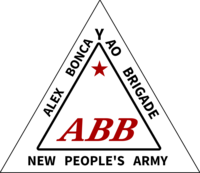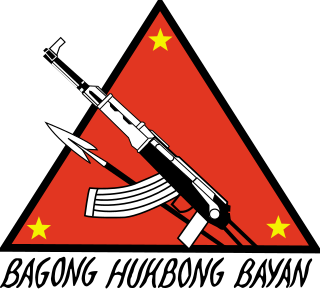
The New People's Army, abbreviated NPA or BHB, is the armed wing of the Communist Party of the Philippines (CPP). It acts as the CPP's principal organization, aiming to consolidate political power from what it sees as the present "bourgeois reactionary puppet government" and to aid in the "people's democratic revolution". Founded on March 29, 1969, by the collaboration of Jose Maria Sison and former members of the Hukbalahap led by Bernabe Buscayno, the NPA has since waged a guerrilla war based on the Maoist strategy of protracted people's war. The NPA is one of the key figures in the ongoing Communist rebellion in the Philippines, the longest ongoing conflict in the country.

The Communist Party of the Philippines is a far-left, Marxist–Leninist–Maoist revolutionary organization and communist party in the Philippines, formed by Jose Maria Sison on 26 December 1968. It is designated as a terrorist group by the United States Department of State together with Sison and its armed wing New People's Army (NPA) in 2002. The European Union renewed its terrorist designation on the organization in 2019, though a 2009 ruling by the EU's second highest court delisted Sison as a "person supporting terrorism" and reversed a decision by member governments to freeze assets. According to the US' Central Intelligence Agency (CIA) World Factbook, the CPP and the NPA aims to destabilize the Philippines' economy and overthrow the national government.

Filemon Castelar Lagman, popularly known as Ka Popoy, was a revolutionary socialist and workers' leader in the Philippines who supported Marxism-Leninism. He split with the Communist Party of the Philippines in 1991 due to ideological disagreements to form Bukluran ng Manggagawang Pilipino (BMP). He was assassinated in 2001.

Edcel Castelar Lagman Sr. is a Filipino human rights lawyer and politician from the province of Albay. He was elected as a member of the House in 1987 to 1998 and 2004 to 2013 and 2016 up to the present. He served as Minority Floor Leader of the House of Representatives of the Philippines until 2012, when he resigned the office. Lagman is one of the key Liberal Party figures in the House of Representatives, having supported the Responsible Parenthood and Reproductive Health Act, the SOGIE Equality Bill, the Free Tertiary Education Act, the Anti-Dynasty Bill, and the Freedom of Information Bill. He is also the principal author of the Divorce Bill, the Human Rights Defenders Bill, the Prevention of Teenage Pregnancy Bill, and the Anti-Child Marriage Bill.

The Revolutionary Workers' Party of the Philippines is a communist party that split from the Communist Party of the Philippines during the Second Great Rectification Movement.

The 5th Infantry Division, Philippine Army, known officially as the Star Division, is the Philippine Army's primary infantry unit in Northern Luzon, and specializes in anti-guerrilla warfare.
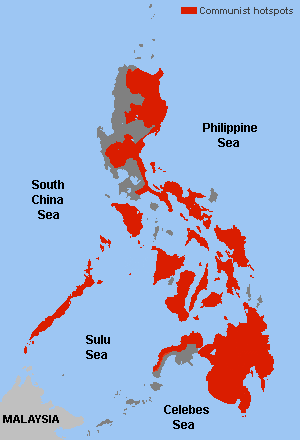
The New People's Army rebellion is an ongoing conflict between the government of the Philippines and the New People's Army (NPA), the armed wing of the Marxist–Leninist–Maoist Communist Party of the Philippines (CPP). It is the world's longest ongoing communist insurgency and the largest, most prominent communist armed conflict in the Philippines, with more than 43,000 insurgency-related fatalities between 1969 and 2008. Due to the involvement of the National Democratic Front of the Philippines (NDFP), the legal wing of the CPP, in the conflict, it is also called the CPP–NPA–NDF conflict, or simply the C/N/N conflict, especially in the context of peace talks with the Philippine government.
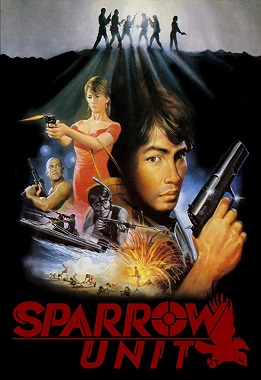
Target: Sparrow Unit is a 1987 Filipino action film directed by Ben "M7" Yalung. It stars Ramon 'Bong' Revilla Jr., Ronnie Ricketts, Debbie Miller, Sonny Parsons, Dick Israel, King Gutierrez and E.R. Ejercito.

The history of the Philippine Army began in during pre-colonial era as different tribes established their own citizen force to defend the Balangays from intruders. Army was organized forces through the years who fought Spanish oppression and even other invaders such as Dutch and British who attempted to conquer the Philippines in early centuries.

The history of communist armed conflicts in the Philippines is closely related to the history of Communism in the Philippines, with various armed conflict linked to the armed wings of the various communist organizations that have evolved since 1930. The two largest conflicts have been the Hukbalahap Rebellion of 1942–1954, and the ongoing rebellion of the New People's Army, which began in 1969 under the auspices of the Communist Party of the Philippines (CPP). But various splinter groups have since separated from the CPP and have had a history of armed conflict with the Philippine government since then.
Communism in the Philippines emerged in the first half of the 20th century during the American colonial era of the Philippines. Communist movements originated in labor unions and peasant groups. The communist movement has had multiple periods of popularity and relevance to the national affairs of the country, most notably during the Second World War and the Martial Law Era of the Philippines. Currently, the communist movement is weaker, and considered an insurgent movement by the Armed Forces of the Philippines.
The Revolutionary Proletarian Army, also known by the acronym RPA, was the military wing of the Revolutionary Workers' Party (RPM-P), a communist party that split from the Communist Party of the Philippines.
The Second Great Rectification Movement refers to a 1992 ideological campaign initiated by the leadership of the Communist Party of the Philippines (CPP) wherein an effort was made to "identify, repudiate and rectify the errors of urban insurrectionism, premature big formations of the New People's Army and anti-infiltration hysteria". The rectification movement resulted in the once monolithic Filipino communist party fragmenting into at least eight warring factions during the 1990s.
Ambush is a 1988 Filipino action film directed by Francis 'Jun' Posadas and written by Jerry O. Tirazona. It stars Ronnie Ricketts, Dick Israel, Sonny Parsons, E.R. Ejercito, Leo Lazaro, Bobby Zshornack, and Beverly Vergel. The film depicts an armed struggle between the New People's Army's Sparrow Unit and the Armed Forces of the Philippines. Produced by Regent Films, Ambush was released in theaters on July 13, 1988.
Dickson Peñas Hermoso is a Filipino government official and former military official who serves as the head of the Ministry of Transportation and Communications of Bangsamoro. He was also known for being part of the Philippine Army's 6th Infantry Division which was involved in the Moro conflict.

Joseph Stephen Paduano, also known by his nom de guerre Carapali Lualhati, is a Filipino politician who previously served as the House Minority Leader from 2020 to 2022. He has been the party-list representative for Abang Lingkod since 2014.
Alex Boncayao Brigade is a 1989 action film directed by Joey del Rosario. The film stars Ronnie Ricketts, Mia Prats, George Estregan Jr., Richard Bonnin and Marco Polo, alongside Dave Brodett, Val Iglesias, Nick Romano, Bomber Moran, and Dexter Doria. It is about the titular communist militant group that functions as the urban guerrilla unit of the New People's Army. Produced by Olympia Pictures, the film was released on January 18, 1989.
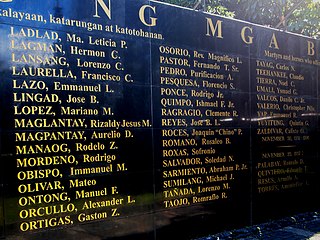
Atty. Hermon Lagman was a Filipino labor lawyer best known for his role in the Philippine labor sector's resistance against the Marcos dictatorship, which resulted in his forced disappearance in 1977. In 1992, he was among the first batch of 65 Martial Law era martyrs to be honored by having their names engraved on the Wall of Remembrance at the Philippines Bantayog ng mga Bayani memorial.

Rolando “Rolly” Abadilla was a Filipino politician and Philippine Constabulary (PC) officer best known for heading the PC Metropolitan Command's Intelligence and Security Group under the dictatorship of Ferdinand Marcos, which became notorious for numerous documented human rights abuses.
